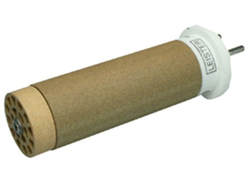|
Inside every Leister hot air tool is a heating element composed of a ceramic honeycomb supported resistance wire filament (See below). Electric resistance wire heaters work on the principle that when electrical current passes through a conductor heat is generated, and the amount of heat generated is related to the resistance of the conductor.  Figure 1: Leister Heating Element Figure 1: Leister Heating Element Some resistance wire heaters are able to function without airflow because they have been designed in such a way that they will not reach temperatures above their safe operating limits. Examples include: a toaster, some ovens, wrap heaters, some space heaters, etc. However, Leister heaters are designed to operate at very high temperatures—most are designed to heat airflows up to 650°C, and some up to 900°C—and as a result require airflow at all times. To reach these high air temperatures, the heating element must be capable of reaching even higher temperatures. Without adequate airflow, the element will heat up unchecked and will exceed safe limits, leading to the destruction of the element. Adequate airflow ensures safe operation of a tool because while the air is heated by the element, the temperature of the element is subsequently kept lower because of the transfer of energy to the airflow. This transfer of energy keeps the element at a safe operating temperature and allows for high temperature outputs. Air must continually pass through the heating element to ensure the temperature does not exceed the safe limits of the materials.
When shutting down Leister heaters it is important to allow them to cool to ambient temperature before the airflow is turned off. This is accomplished by reducing the heating power of the tool to zero and allowing the air to continue running for several minutes. STANMECH recommends a 5 minute cool down period as a rule of thumb. If a cool down cycle is not performed at shutdown and the tool is turned off hot, the ceramic portion of the heating element will suffer from thermal shock and can crack. This will also drastically reduce the expected life span of your heating element. If you treat your heating elements with care, always ensuring adequate airflow and using an acceptable cool down cycle, your elements will last a very long time. However if these best practices are not followed, the heating element will fail early. If you have any questions relating to this article or Leister heaters in general, please call STANMECH. We are happy to help. Comments are closed.
|
|
STANMECH Technologies Inc.
944 Zelco Drive Burlington ON L7L 4Y3 | 1-888-438-6324 | [email protected] Terms of Use Privacy Terms and Conditions of Sale Warranty Policies |
|
Proud Member of:

